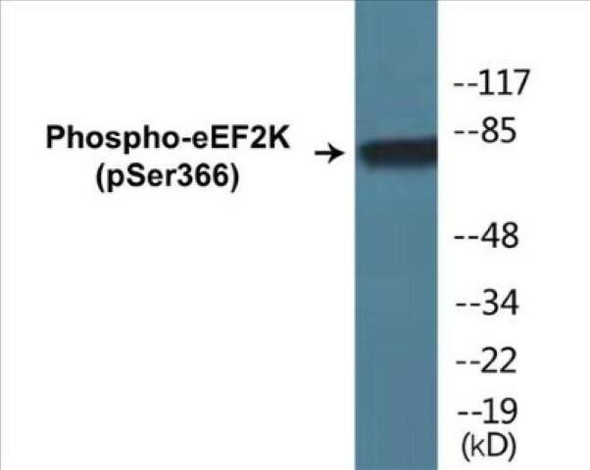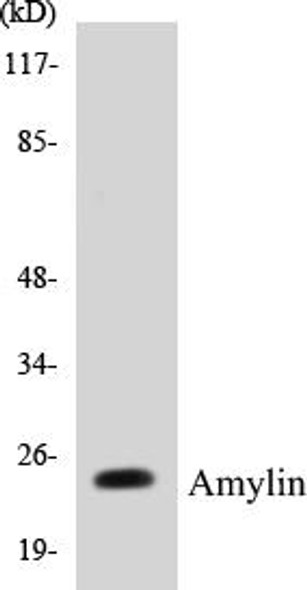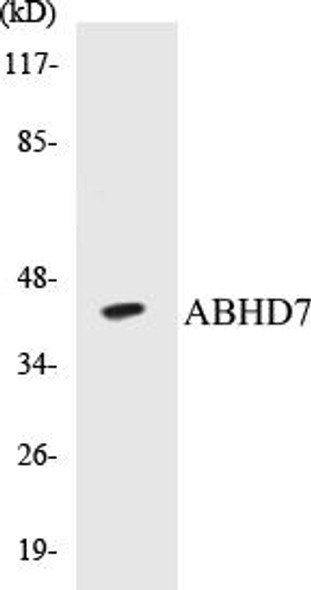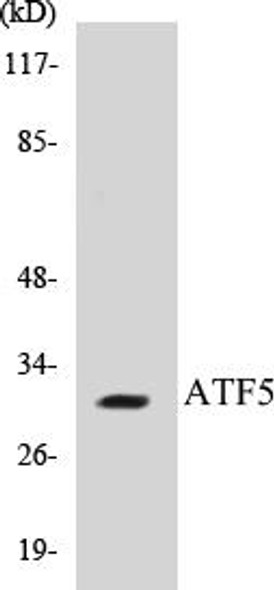Description
eEF2K Colorimetric Cell-Based ELISA Kit
The EEF2K Colorimetric Cell-Based ELISA Kit is specifically designed for the accurate detection of Eukaryotic Elongation Factor 2 Kinase (EEF2K) levels in cell lysates and tissue homogenates. This kit provides high sensitivity and specificity, allowing for precise and reliable results in various research applications.EEF2K is a key regulator of protein synthesis and cell growth, playing a critical role in processes such as cell proliferation, apoptosis, and autophagy.
Dysregulation of EEF2K has been linked to various diseases, including cancer, neurodegenerative disorders, and metabolic diseases, making it a valuable target for therapeutic intervention.With the EEF2K Colorimetric Cell-Based ELISA Kit, researchers can easily quantify EEF2K levels in their samples, enabling detailed studies on its biological functions and potential therapeutic implications. Get accurate and reproducible results with this advanced ELISA kit.
| Product Name: | eEF2K Colorimetric Cell-Based ELISA |
| Product Code: | CBCAB00631 |
| ELISA Type: | Cell-Based |
| Target: | eEF2K |
| Reactivity: | Human, Rat |
| Dynamic Range: | > 5000 Cells |
| Detection Method: | Colorimetric 450 nmStorage/Stability:4°C/6 Months |
| Format: | 96-Well Microplate |
The eEF2K Colorimetric Cell-Based ELISA Kit is a convenient, lysate-free, high throughput and sensitive assay kit that can detect eEF2K protein expression profile in cells. The kit can be used for measuring the relative amounts of eEF2K in cultured cells as well as screening for the effects that various treatments, inhibitors (ie siRNA or chemicals), or activators have on eEF2K.
Qualitative determination of eEF2K concentration is achieved by an indirect ELISA format. In essence, eEF2K is captured by eEF2K-specific primary antibodies while the HRP-conjugated secondary antibodies bind the Fc region of the primary antibody. Through this binding, the HRP enzyme conjugated to the secondary antibody can catalyze a colorimetric reaction upon substrate addition. Due to the qualitative nature of the Cell-Based ELISA, multiple normalization methods are needed:
| 1. | A monoclonal antibody specific for human GAPDH is included to serve as an internal positive control in normalizing the target absorbance values. |
| 2. | Following the colorimetric measurement of HRP activity via substrate addition, the Crystal Violet whole-cell staining method may be used to determine cell density. After staining, the results can be analysed by normalizing the absorbance values to cell amounts, by which the plating difference can be adjusted. |
| Database Information: | Gene ID: 29904, UniProt ID: O00418, OMIM: 606968, Unigene: Hs.498892 |
| Gene Symbol: | EEF2K |
| Sub Type: | None |
| UniProt Protein Function: | EEF2K: an atypical protein kinase of the Alpha family. Dependent on Ca2 ions and calmodulin. May play a key role linking cellular energy status and the inhibition of protein synthesis, a major consumer of metabolic energy. Phosphorylates and inactivates eEF2, resulting in the inhibition of peptide-chain elongation eEF2K is phosphorylated and activated by AMPK in response to elevated AMP levels, which increase during cellular stress and starvation. Regulated in response to a range of stimuli including TNF-alpha. Overexpressed in breast cancer cell lines and tumors. Activated in rat glioblastoma, and growth was inhibited by the drug Rottlerin. Activity induced in ischemic heart muscle |
| UniProt Protein Details: | Protein type:Protein kinase, Ser/Thr (non-receptor); Translation; Kinase, protein; Protein kinase, atypical; EC 2.7.11.20; ATYPICAL group; Alpha family; eEF2K subfamily Chromosomal Location of Human Ortholog: 16p12.2 Cellular Component: cytoplasm; cytosol Molecular Function:calmodulin binding; elongation factor-2 kinase activity; translation factor activity, nucleic acid binding; calcium ion binding; ATP binding; protein kinase activity Biological Process: translational elongation; regulation of protein amino acid autophosphorylation; protein amino acid autophosphorylation; insulin receptor signaling pathway |
| NCBI Summary: | This gene encodes a highly conserved protein kinase in the calmodulin-mediated signaling pathway that links activation of cell surface receptors to cell division. This kinase is involved in the regulation of protein synthesis. It phosphorylates eukaryotic elongation factor 2 (EEF2) and thus inhibits the EEF2 function. The activity of this kinase is increased in many cancers and may be a valid target for anti-cancer treatment. [provided by RefSeq, Jul 2008] |
| UniProt Code: | O00418 |
| NCBI GenInfo Identifier: | 254763289 |
| NCBI Gene ID: | 29904 |
| NCBI Accession: | O00418.2 |
| UniProt Secondary Accession: | O00418,Q8N588, |
| UniProt Related Accession: | O00418 |
| Molecular Weight: | 725 |
| NCBI Full Name: | Eukaryotic elongation factor 2 kinase |
| NCBI Synonym Full Names: | eukaryotic elongation factor 2 kinase |
| NCBI Official Symbol: | EEF2K |
| NCBI Official Synonym Symbols: | eEF-2K; HSU93850 |
| NCBI Protein Information: | eukaryotic elongation factor 2 kinase; eEF-2 kinase; elongation factor-2 kinase; eukaroytic elongation factor 2 kinase; eukaryotic elongation factor-2 kinase; calmodulin-dependent protein kinase III; calcium/calmodulin-dependent eukaryotic elongation factor 2 kinase; calcium/calmodulin-dependent eukaryotic elongation factor-2 kinase |
| UniProt Protein Name: | Eukaryotic elongation factor 2 kinase |
| UniProt Synonym Protein Names: | Calcium/calmodulin-dependent eukaryotic elongation factor 2 kinase |
| Protein Family: | Eukaryotic elongation factor 2 kinase |
| UniProt Gene Name: | EEF2K |
| UniProt Entry Name: | EF2K_HUMAN |
| Component | Quantity |
| 96-Well Cell Culture Clear-Bottom Microplate | 2 plates |
| 10X TBS | 24 mL |
| Quenching Buffer | 24 mL |
| Blocking Buffer | 50 mL |
| 15X Wash Buffer | 50 mL |
| Primary Antibody Diluent | 12 mL |
| 100x Anti-Phospho Target Antibody | 60 µL |
| 100x Anti-Target Antibody | 60 µL |
| Anti-GAPDH Antibody | 60 µL |
| HRP-Conjugated Anti-Rabbit IgG Antibody | 12 mL |
| HRP-Conjugated Anti-Mouse IgG Antibody | 12 mL |
| SDS Solution | 12 mL |
| Stop Solution | 24 mL |
| Ready-to-Use Substrate | 12 mL |
| Crystal Violet Solution | 12 mL |
| Adhesive Plate Seals | 2 seals |
The following materials and/or equipment are NOT provided in this kit but are necessary to successfully conduct the experiment:
- Microplate reader able to measure absorbance at 450 nm and/or 595 nm for Crystal Violet Cell Staining (Optional)
- Micropipettes with capability of measuring volumes ranging from 1 µL to 1 ml
- 37% formaldehyde (Sigma Cat# F-8775) or formaldehyde from other sources
- Squirt bottle, manifold dispenser, multichannel pipette reservoir or automated microplate washer
- Graph paper or computer software capable of generating or displaying logarithmic functions
- Absorbent papers or vacuum aspirator
- Test tubes or microfuge tubes capable of storing ≥1 ml
- Poly-L-Lysine (Sigma Cat# P4832 for suspension cells)
- Orbital shaker (optional)
- Deionized or sterile water
*Note: Protocols are specific to each batch/lot. For the correct instructions please follow the protocol included in your kit.
| Step | Procedure |
| 1. | Seed 200 µL of 20,000 adherent cells in culture medium in each well of a 96-well plate. The plates included in the kit are sterile and treated for cell culture. For suspension cells and loosely attached cells, coat the plates with 100 µL of 10 µg/ml Poly-L-Lysine (not included) to each well of a 96-well plate for 30 minutes at 37°C prior to adding cells. |
| 2. | Incubate the cells for overnight at 37°C, 5% CO2. |
| 3. | Treat the cells as desired. |
| 4. | Remove the cell culture medium and rinse with 200 µL of 1x TBS, twice. |
| 5. | Fix the cells by incubating with 100 µL of Fixing Solution for 20 minutes at room temperature. The 4% formaldehyde is used for adherent cells and 8% formaldehyde is used for suspension cells and loosely attached cells. |
| 6. | Remove the Fixing Solution and wash the plate 3 times with 200 µL 1x Wash Buffer for five minutes each time with gentle shaking on the orbital shaker. The plate can be stored at 4°C for a week. |
| 7. | Add 100 µL of Quenching Buffer and incubate for 20 minutes at room temperature. |
| 8. | Wash the plate 3 times with 1x Wash Buffer for 5 minutes each time. |
| 9. | Add 200 µL of Blocking Buffer and incubate for 1 hour at room temperature. |
| 10. | Wash 3 times with 200 µL of 1x Wash Buffer for 5 minutes each time. |
| 11. | Add 50 µL of 1x primary antibodies (Anti-eEF2K Antibody and/or Anti-GAPDH Antibody) to the corresponding wells, cover with Parafilm and incubate for 16 hours (overnight) at 4°C. If the target expression is known to be high, incubate for 2 hours at room temperature. |
| 12. | Wash 3 times with 200 µL of 1x Wash Buffer for 5 minutes each time. |
| 13. | Add 50 µL of 1x secondary antibodies (HRP-Conjugated AntiRabbit IgG Antibody or HRP-Conjugated Anti-Mouse IgG Antibody) to corresponding wells and incubate for 1.5 hours at room temperature. |
| 14. | Wash 3 times with 200 µL of 1x Wash Buffer for 5 minutes each time. |
| 15. | Add 50 µL of Ready-to-Use Substrate to each well and incubate for 30 minutes at room temperature in the dark. |
| 16. | Add 50 µL of Stop Solution to each well and read OD at 450 nm immediately using the microplate reader. |
(Additional Crystal Violet staining may be performed if desired – details of this may be found in the kit technical manual.)






